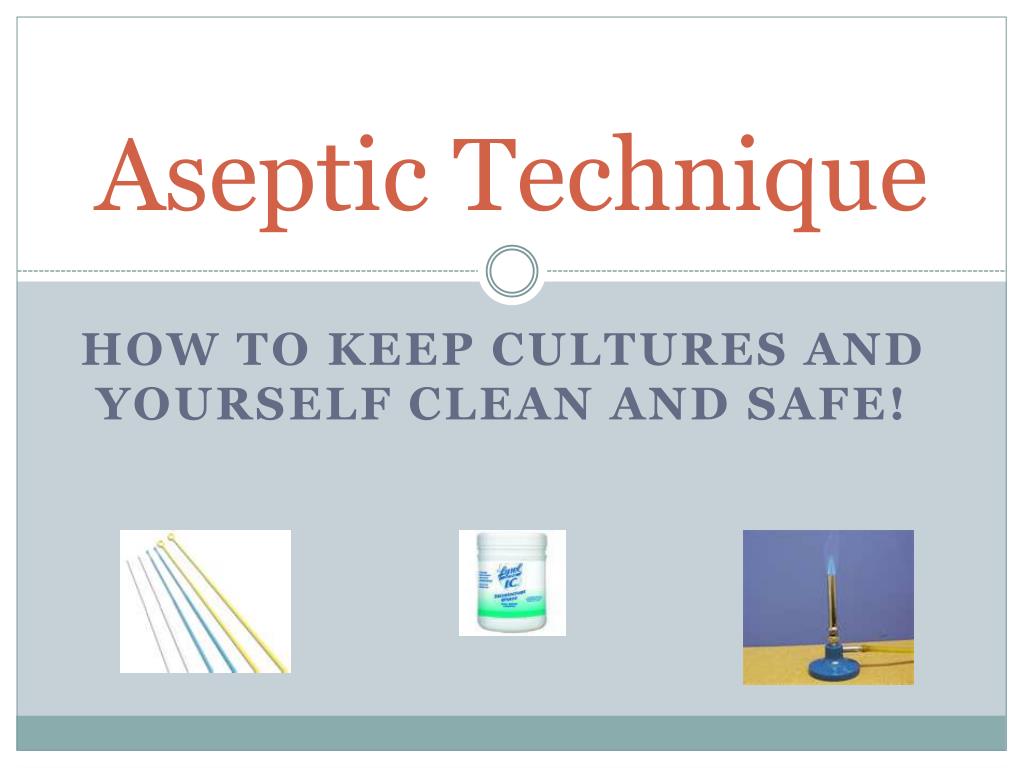
RACGP submission – Audit of the Community Health and Hospitals Program RACGP submission to the senate inquiry into universal access to reproductive healthcare Submission to the National Health Practitioner Ombudsman – Review of Ahpra’s vexatious notifications RACGP submission to the Australian Pharmacy Council on the Accreditation Standards for Pharmacist Tr RACGP submission to the Amendment to Healthcare Identifiers Regulations 2020 Consultation – Active S
#PRINCIPLES OF ASEPTIC TECHNIQUE PRO#
Letter from RACGP to the Medical Board of Australia - Guidelines - cosmetic medical and surgical pro RACGP Submission to the National Health Reform Agreement Addendum 2020-2025 Mid-term Review RACGP response to ACCC review of the merger between Australian Clinical Labs Limited and Healius Lim Preventive healthcare and the Medicare Benefits Schedule Medicare Benefits Schedule / Medicare compliance - Summary of useful links RACGP statement on Medicare interpretation and compliance.Resources to help GPs support patients to access the NDISĬlimate change and health – Practice postersįAQ on changes to consent and release of patient information to life insurers General practice policy and procedure templates

How technology can help you look after your health RACGP Steriliser Record System - logbook and templates National Disability Insurance Scheme: Information for general practitioners Improving health record quality in general practice Telehealth and supervision: A guide for GPs in training and their supervisorsĬoronavirus (COVID-19) information for GPsĭrugs of dependence: Responding to requestsĪ guide for ensuring good referral outcomes for your patients Telehealth consultations using an interpreter Telephone and video consultations in general practice: Flowcharts Guide to providing telephone and video consultations in general practice Items for COVID-19 telehealth and phone services Having a phone or video consultation with your regular GP: Information and support for patients How can I get proof of my COVID-19 vaccinations? Patient resource: Managing post–COVID-19 symptoms Oral treatments for COVID-19 – Prescribing information for GPs

Surgical and medical aseptic techniques encompass similar strategies such as hand hygiene but with distinct differences.Home-care guidelines for patients with COVID-19Ĭaring for patients with post–COVID-19 conditions Insertion and maintenance of invasive devices are guided by published evidenced-based recommendations supporting education, training, and standardized care for patients with central lines, surgical sites, ventilators, and urinary catheters. You do not have permission to view this object. A Compendium of Strategies to Prevent Healthcare-Associated Infections in Acute Care Hospitals. Clean technique leads to a decrease of the overall number of microorganisms present rather than the absence of microorganisms as is found in surgical asepsis.Ref 30-3 Yokoe DS, Mermel LA, Anderson DJ, et al. Clean technique, or medical asepsis, is another practice to prevent or reduce the risk of transmission of organisms from one person to another or from one place to another. Situations in which surgical asepsis technique is applied include surgery as well as other areas where invasive procedures are done such as placement of intravenous lines, urinary catheters, chest tubes, and any other indwelling devices. You do not have permission to view this object.Īseptic techniques, defined as the process for keeping away disease-producing microorganisms, may be used in any clinical setting. Guideline for hand hygiene in health-care settings: Recommendations of the Healthcare Infectio. You do not have permission to view this object.Īseptic technique improves patient safety and prevents healthcare-associated infections that may negatively impact outcomes including: increasing patient morbidity and mortality, increasing healthcare costs for patients and their families, prolonging length of stay, increasing resistance of microorganisms to antimicrobials, and increasing physical and mental discomfort for the patient.Ref 30-2 Centers for Disease Control and Prevention. Following observations of Ignaz Semmelweis and others over 100 years ago, the practice of aseptic technique is an infection prevention method that is recognized as an important factor in the prevention and transmission of healthcare-associated infections.Ref 30-1 Association of Perioperative Registered Nurses (AORN).


 0 kommentar(er)
0 kommentar(er)
